Welcome to the Dapr concepts guide!
Getting started with Dapr
If you are ready to jump in and start developing with Dapr, please visit the getting started section.
This is the multi-page printable view of this section. Click here to print.
Welcome to the Dapr concepts guide!
If you are ready to jump in and start developing with Dapr, please visit the getting started section.
Dapr is a portable, event-driven runtime that makes it easy for any developer to build resilient, stateless, and stateful applications that run on the cloud and edge and embraces the diversity of languages and developer frameworks.

With the current wave of cloud adoption, web + database application architectures (such as classic 3-tier designs) are trending more toward microservice application architectures, which are inherently distributed. You shouldn’t have to become a distributed systems expert just to create microservices applications.
This is where Dapr comes in. Dapr codifies the best practices for building microservice applications into open, independent APIs called building blocks. Dapr’s building blocks:
Using Dapr, you can incrementally migrate your existing applications to a microservices architecture, thereby adopting cloud native patterns such scale out/in, resiliency, and independent deployments.
Dapr is platform agnostic, meaning you can run your applications:
This enables you to build microservice applications that can run on the cloud and edge.
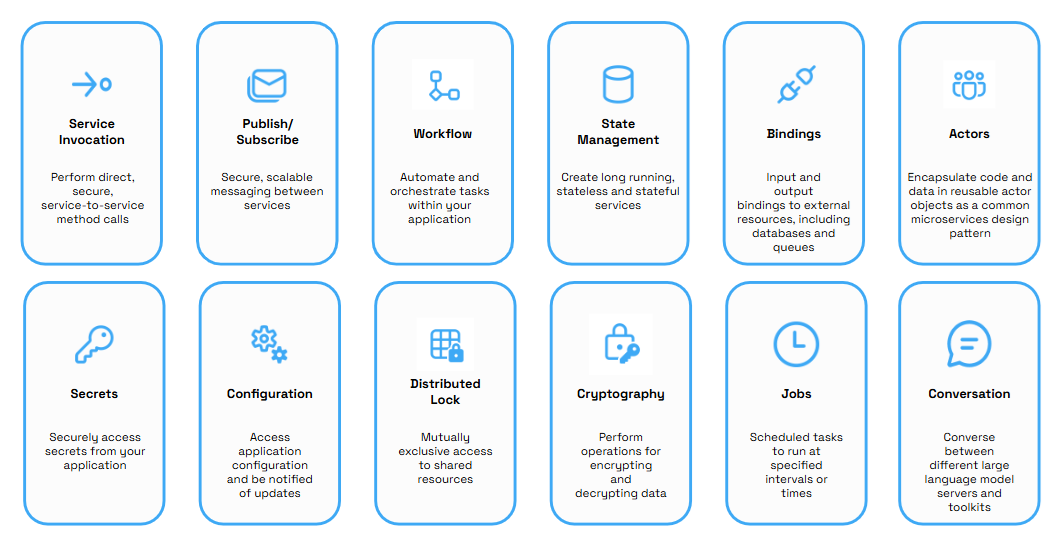
Dapr provides distributed system building blocks for you to build microservice applications in a standard way and to deploy to any environment.
Each of these building block APIs is independent, meaning that you can use any number of them in your application.
| Building Block | Description |
|---|---|
| Service-to-service invocation | Resilient service-to-service invocation enables method calls, including retries, on remote services, wherever they are located in the supported hosting environment. |
| Publish and subscribe | Publishing events and subscribing to topics between services enables event-driven architectures to simplify horizontal scalability and make them resilient to failure. Dapr provides at-least-once message delivery guarantee, message TTL, consumer groups and other advance features. |
| Workflows | The workflow API can be combined with other Dapr building blocks to define long running, persistent processes or data flows that span multiple microservices using Dapr workflows. |
| State management | With state management for storing and querying key/value pairs, long-running, highly available, stateful services can be easily written alongside stateless services in your application. The state store is pluggable and examples include AWS DynamoDB, Azure Cosmos DB, Azure SQL Server, GCP Firebase, PostgreSQL or Redis, among others. |
| Resource bindings | Resource bindings with triggers builds further on event-driven architectures for scale and resiliency by receiving and sending events to and from any external source such as databases, queues, file systems, etc. |
| Actors | A pattern for stateful and stateless objects that makes concurrency simple, with method and state encapsulation. Dapr provides many capabilities in its actor runtime, including concurrency, state, and life-cycle management for actor activation/deactivation, and timers and reminders to wake up actors. |
| Secrets | The secrets management API integrates with public cloud and local secret stores to retrieve the secrets for use in application code. |
| Configuration | The configuration API enables you to retrieve and subscribe to application configuration items from configuration stores. |
| Distributed lock | The distributed lock API enables your application to acquire a lock for any resource that gives it exclusive access until either the lock is released by the application, or a lease timeout occurs. |
| Cryptography | The cryptography API provides an abstraction layer on top of security infrastructure such as key vaults. It contains APIs that allow you to perform cryptographic operations, such as encrypting and decrypting messages, without exposing keys to your applications. |
| Jobs | The jobs API enables you to schedule jobs at specific times or intervals. |
| Conversation | The conversation API enables you to abstract the complexities of interacting with large language models (LLMs) and includes features such as prompt caching and personally identifiable information (PII) obfuscation. Using conversation components, you can supply prompts to converse with different LLMs. |
Alongside its building blocks, Dapr provides cross-cutting APIs that apply across all the build blocks you use.
| Building Block | Description |
|---|---|
| Resiliency | Dapr provides the capability to define and apply fault tolerance resiliency policies via a resiliency spec. Supported specs define policies for resiliency patterns such as timeouts, retries/back-offs, and circuit breakers. |
| Observability | Dapr emits metrics, logs, and traces to debug and monitor both Dapr and user applications. Dapr supports distributed tracing to easily diagnose and serve inter-service calls in production using the W3C Trace Context standard and Open Telemetry to send to different monitoring tools. |
| Security | Dapr supports in-transit encryption of communication between Dapr instances using the Dapr control plane, Sentry service. You can bring in your own certificates, or let Dapr automatically create and persist self-signed root and issuer certificates. |
Dapr exposes its HTTP and gRPC APIs as a sidecar architecture, either as a container or as a process, not requiring the application code to include any Dapr runtime code. This makes integration with Dapr easy from other runtimes, as well as providing separation of the application logic for improved supportability.
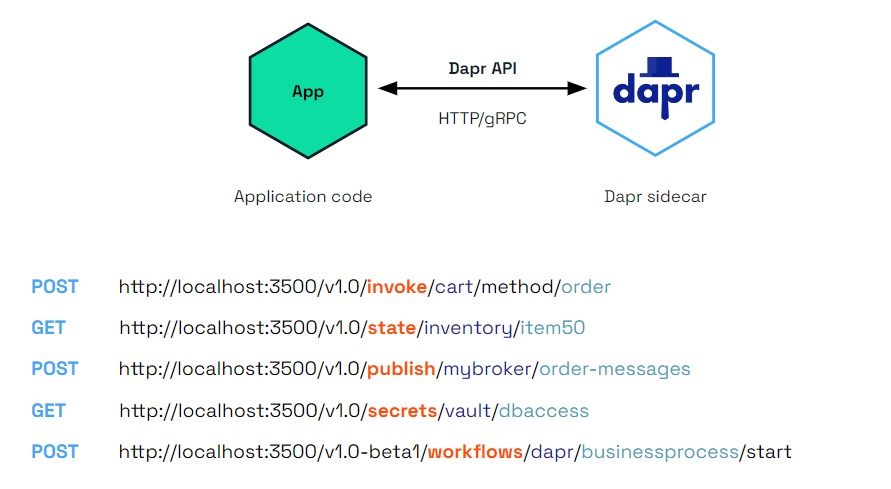
Dapr can be hosted in multiple environments, including:
In self-hosted mode, Dapr runs as a separate sidecar process, which your service code can call via HTTP or gRPC. Each running service has a Dapr runtime process (or sidecar) configured to use state stores, pub/sub, binding components, and the other building blocks.
You can use the Dapr CLI to run a Dapr-enabled application on your local machine. In the following diagram, Dapr’s local development environment gets configured with the CLI init command. Try this out with the getting started samples.
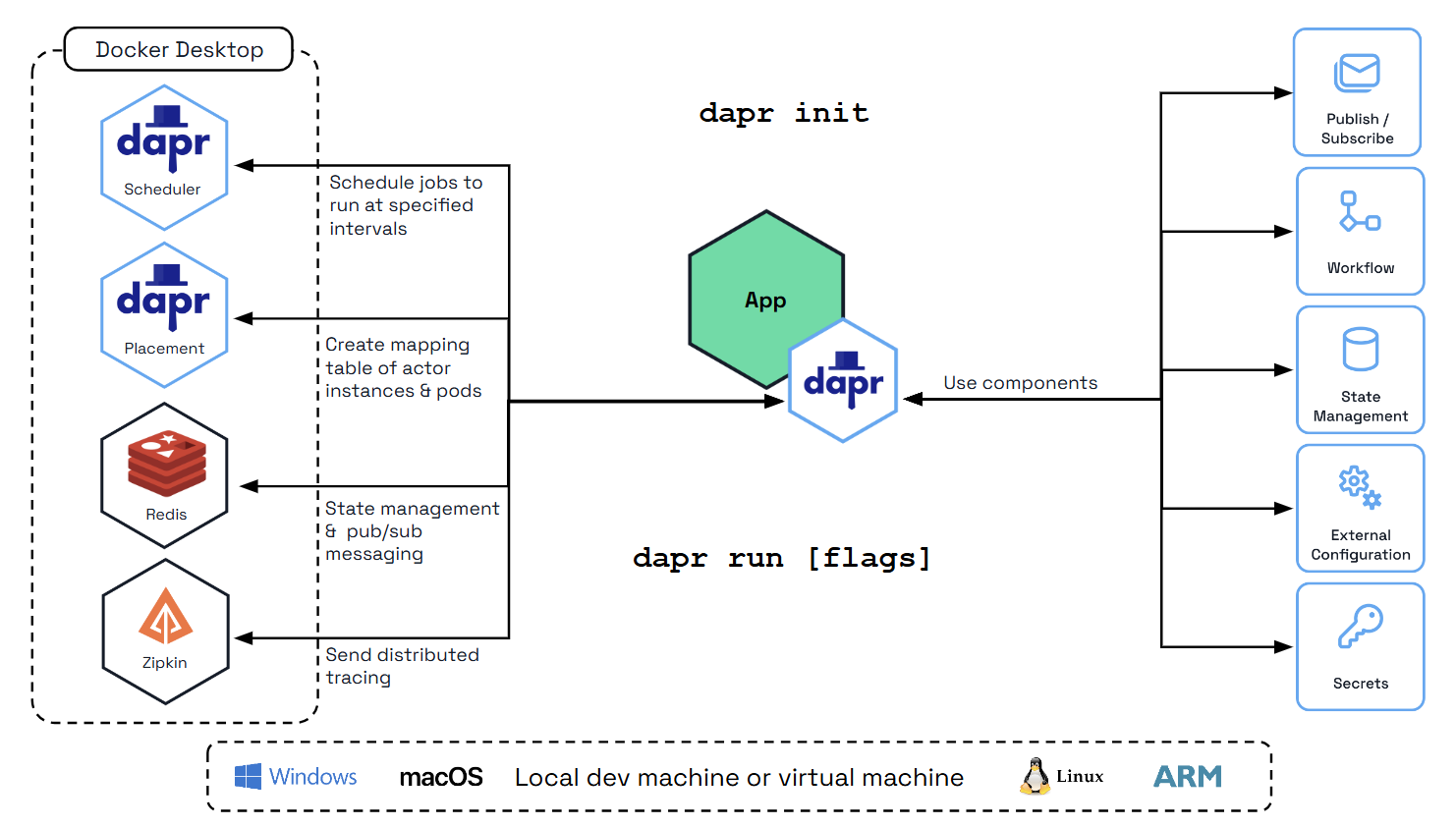
Kubernetes can be used for either:
In container hosting environments such as Kubernetes, Dapr runs as a sidecar container with the application container in the same pod.
Dapr’s dapr-sidecar-injector and dapr-operator control plane services provide first-class integration to:
The dapr-sentry service is a certificate authority that enables mutual TLS between Dapr sidecar instances for secure data encryption, as well as providing identity via Spiffe. For more information on the Sentry service, read the security overview
Deploying and running a Dapr-enabled application into your Kubernetes cluster is as simple as adding a few annotations to the deployment schemes. Visit the Dapr on Kubernetes docs.
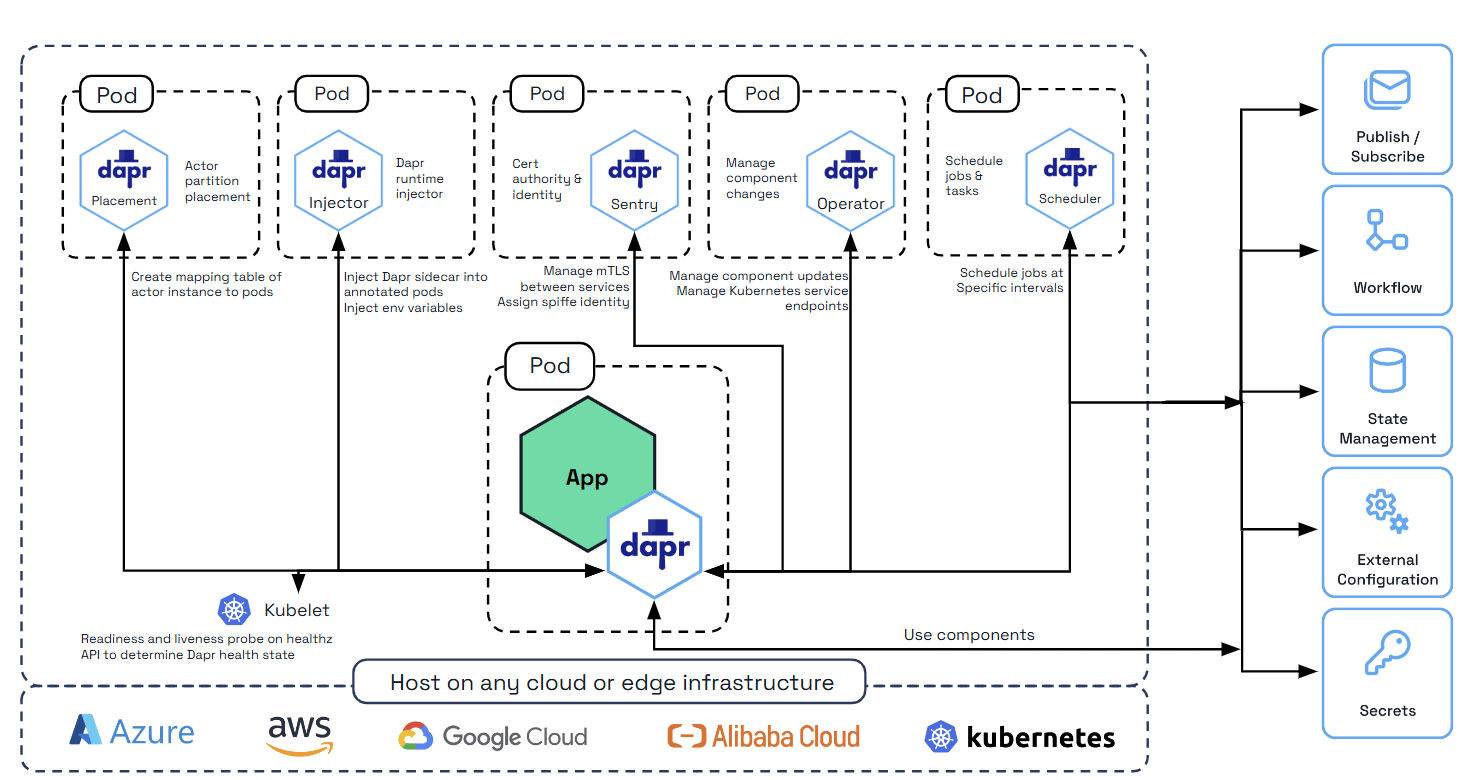
The Dapr control plane services can be deployed in high availability (HA) mode to clusters of physical or virtual machines in production. In the diagram below, the Actor Placement and security Sentry services are started on three different VMs to provide HA control plane. In order to provide name resolution using DNS for the applications running in the cluster, Dapr uses multicast DNS by default, but can also optionally support Hashicorp Consul service.
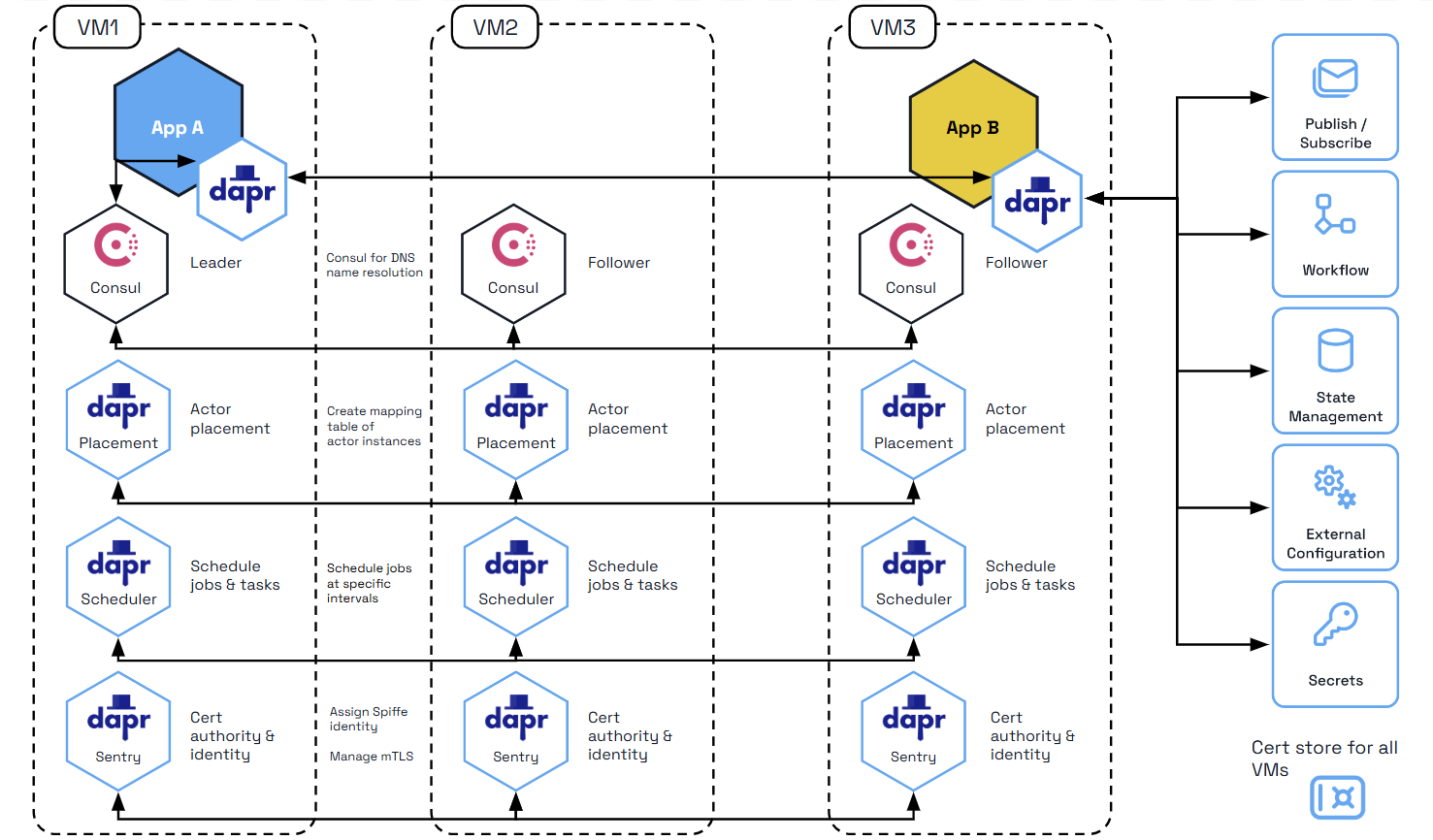
Dapr offers a variety of SDKs and frameworks to make it easy to begin developing with Dapr in your preferred language.
To make using Dapr more natural for different languages, it also includes language specific SDKs for:
These SDKs expose the functionality of the Dapr building blocks through a typed language API, rather than calling the http/gRPC API. This enables you to write a combination of stateless and stateful functions and actors all in the language of your choice. Since these SDKs share the Dapr runtime, you get cross-language actor and function support.
Dapr can be used from any developer framework. Here are some that have been integrated with Dapr:
| Language | Frameworks | Description |
|---|---|---|
| .NET | ASP.NET Core | Brings stateful routing controllers that respond to pub/sub events from other services. Can also take advantage of ASP.NET Core gRPC Services. |
| Java | Spring Boot | Build Spring boot applications with Dapr APIs |
| Python | Flask | Build Flask applications with Dapr APIs |
| JavaScript | Express | Build Express applications with Dapr APIs |
| PHP | You can serve with Apache, Nginx, or Caddyserver. |
Visit the integrations page to learn about some of the first-class support Dapr has for various frameworks and external products, including:
Dapr is designed for operations and security. The Dapr sidecars, runtime, components, and configuration can all be managed and deployed easily and securely to match your organization’s needs.
The dashboard, installed via the Dapr CLI, provides a web-based UI enabling you to see information, view logs, and more for running Dapr applications.
Dapr supports monitoring tools for deeper visibility into the Dapr system services and sidecars, while the observability capabilities of Dapr provide insights into your application, such as tracing and metrics.
A building block is an HTTP or gRPC API that can be called from your code and uses one or more Dapr components. Dapr consists of a set of API building blocks, with extensibility to add new building blocks. Dapr’s building blocks:
The diagram below shows how building blocks expose a public API that is called from your code, using components to implement the building blocks’ capability.
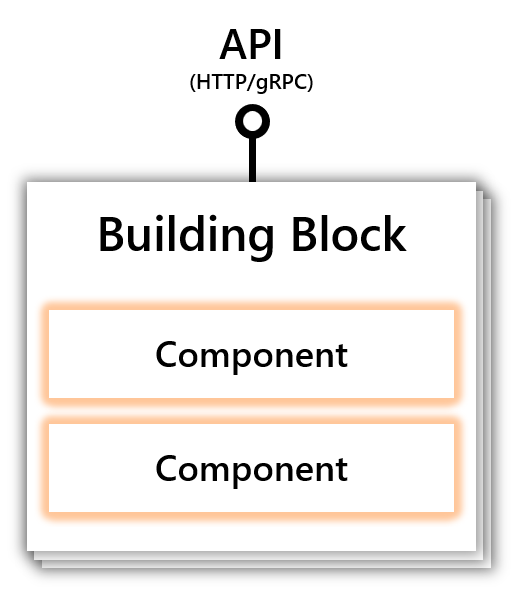
Dapr provides the following building blocks:

| Building Block | Endpoint | Description |
|---|---|---|
| Service-to-service invocation | /v1.0/invoke | Service invocation enables applications to communicate with each other through well-known endpoints in the form of http or gRPC messages. Dapr provides an endpoint that acts as a combination of a reverse proxy with built-in service discovery, while leveraging built-in distributed tracing and error handling. |
| Publish and subscribe | /v1.0/publish /v1.0/subscribe | Pub/Sub is a loosely coupled messaging pattern where senders (or publishers) publish messages to a topic, to which subscribers subscribe. Dapr supports the pub/sub pattern between applications. |
| Workflows | /v1.0/workflow | The Workflow API enables you to define long running, persistent processes or data flows that span multiple microservices using Dapr workflows. The Workflow API can be combined with other Dapr API building blocks. For example, a workflow can call another service with service invocation or retrieve secrets, providing flexibility and portability. |
| State management | /v1.0/state | Application state is anything an application wants to preserve beyond a single session. Dapr provides a key/value-based state and query APIs with pluggable state stores for persistence. |
| Bindings | /v1.0/bindings | A binding provides a bi-directional connection to an external cloud/on-premise service or system. Dapr allows you to invoke the external service through the Dapr binding API, and it allows your application to be triggered by events sent by the connected service. |
| Actors | /v1.0/actors | An actor is an isolated, independent unit of compute and state with single-threaded execution. Dapr provides an actor implementation based on the virtual actor pattern which provides a single-threaded programming model and where actors are garbage collected when not in use. |
| Secrets | /v1.0/secrets | Dapr provides a secrets building block API and integrates with secret stores such as public cloud stores, local stores and Kubernetes to store the secrets. Services can call the secrets API to retrieve secrets, for example to get a connection string to a database. |
| Configuration | /v1.0/configuration | The Configuration API enables you to retrieve and subscribe to application configuration items for supported configuration stores. This enables an application to retrieve specific configuration information, for example, at start up or when configuration changes are made in the store. |
| Distributed lock | /v1.0-alpha1/lock | The distributed lock API enables you to take a lock on a resource so that multiple instances of an application can access the resource without conflicts and provide consistency guarantees. |
| Cryptography | /v1.0-alpha1/crypto | The Cryptography API enables you to perform cryptographic operations, such as encrypting and decrypting messages, without exposing keys to your application. |
| Jobs | /v1.0-alpha1/jobs | The Jobs API enables you to schedule and orchestrate jobs. Example scenarios include:
|
| Conversation | /v1.0-alpha1/conversation | The Conversation API enables you to supply prompts to converse with different large language models (LLMs) and includes features such as prompt caching and personally identifiable information (PII) obfuscation. |
Dapr uses a modular design where functionality is delivered as a component. Each component has an interface definition. All of the components are interchangeable so that you can swap out one component with the same interface for another.
You can contribute implementations and extend Dapr’s component interfaces capabilities via:
A building block can use any combination of components. For example, the actors and the state management building blocks both use state components.
As another example, the pub/sub building block uses pub/sub components.
You can get a list of current components available in the hosting environment using the dapr components CLI command.
--memory option. For Kubernetes, use the dapr.io/sidecar-memory-limit annotation. For processes this depends on the OS and/or process orchestration tools.*Each component has a specification (or spec) that it conforms to. Components are configured at design-time with a YAML file which is stored in either:
components/local folder within your solution, or.dapr folder created when invoking dapr init.These YAML files adhere to the generic Dapr component schema, but each is specific to the component specification.
It is important to understand that the component spec values, particularly the spec metadata, can change between components of the same component type, for example between different state stores, and that some design-time spec values can be overridden at runtime when making requests to a component’s API. As a result, it is strongly recommended to review a component’s specs, paying particular attention to the sample payloads for requests to set the metadata used to interact with the component.
The diagram below shows some examples of the components for each component type
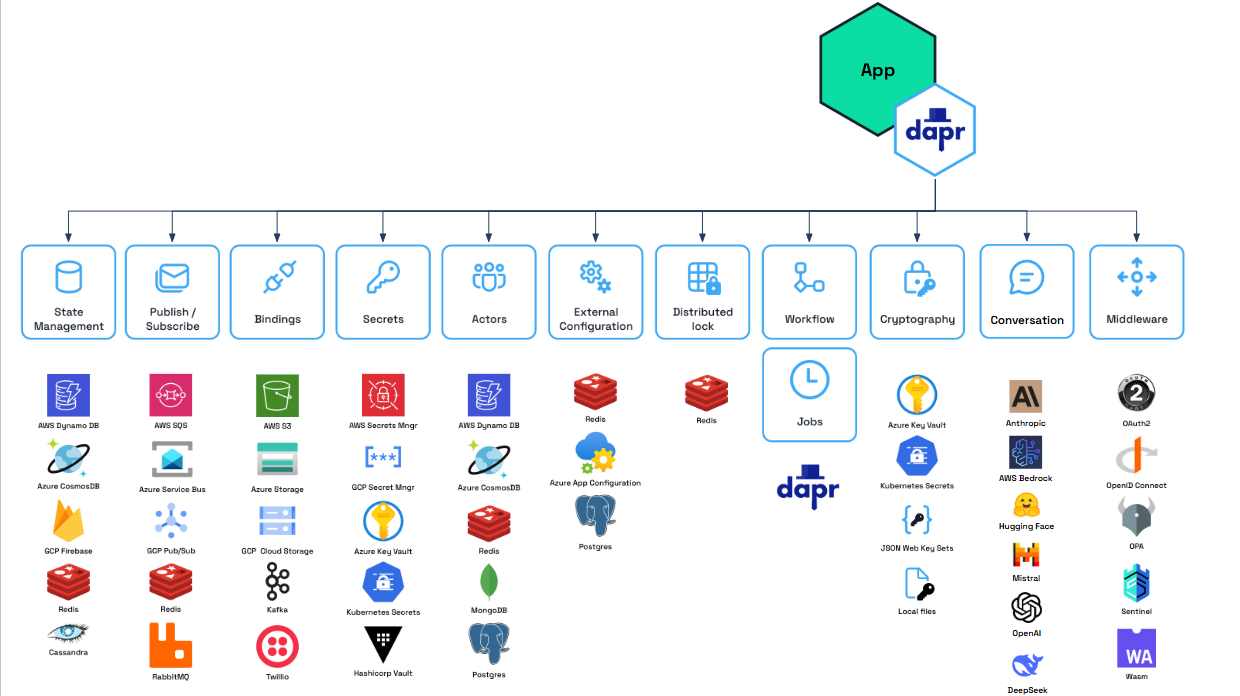
Dapr has built-in components that are included as part of the runtime. These are public components that are developed and donated by the community and are available to use in every release.
Dapr also allows for users to create their own private components called pluggable components. These are components that are self-hosted (process or container), do not need to be written in Go, exist outside the Dapr runtime, and are able to “plug” into Dapr to utilize the building block APIs.
Where possible, donating built-in components to the Dapr project and community is encouraged.
However, pluggable components are ideal for scenarios where you want to create your own private components that are not included into the Dapr project. For example:
For more information read Pluggable components overview
With the HotReload feature enabled, components are able to be “hot reloaded” at runtime.
This means that you can update component configuration without restarting the Dapr runtime.
Component reloading occurs when a component resource is created, updated, or deleted, either in the Kubernetes API or in self-hosted mode when a file is changed in the resources directory.
When a component is updated, the component is first closed, and then reinitialized using the new configuration.
The component is unavailable for a short period of time during reload and reinitialization.
The following are the component types provided by Dapr:
Name resolution components are used with the service invocation building block to integrate with the hosting environment and provide service-to-service discovery. For example, the Kubernetes name resolution component integrates with the Kubernetes DNS service, self-hosted uses mDNS and clusters of VMs can use the Consul name resolution component.
Pub/sub broker components are message brokers that can pass messages to/from services as part of the publish & subscribe building block.
State store components are data stores (databases, files, memory) that store key-value pairs as part of the state management building block.
External resources can connect to Dapr in order to trigger a method on an application or be called from an application as part of the bindings building block.
A secret is any piece of private information that you want to guard against unwanted access. Secrets stores are used to store secrets that can be retrieved and used in applications.
Configuration stores are used to save application data, which can then be read by application instances on startup or notified of when changes occur. This allows for dynamic configuration.
Lock components are used as a distributed lock to provide mutually exclusive access to a resource such as a queue or database.
Cryptography components are used to perform cryptographic operations, including encrypting and decrypting messages, without exposing keys to your application.
Dapr provides developers a way to abstract interactions with large language models (LLMs) with built-in security and reliability features. Use conversation components to send prompts to different LLMs, along with the conversation context.
Dapr allows custom middleware to be plugged into the HTTP request processing pipeline. Middleware can perform additional actions on an HTTP request (such as authentication, encryption, and message transformation) before the request is routed to the user code, or the response is returned to the client. The middleware components are used with the service invocation building block.
With Dapr configurations, you use settings and policies to change:
For example, set a sampling rate policy on the application sidecar configuration to indicate which methods can be called from another application. If you set a policy on the Dapr control plane configuration, you can change the certificate renewal period for all certificates that are deployed to application sidecar instances.
Configurations are defined and deployed as a YAML file. In the following application configuration example, a tracing endpoint is set for where to send the metrics information, capturing all the sample traces.
apiVersion: dapr.io/v1alpha1
kind: Configuration
metadata:
name: daprConfig
namespace: default
spec:
tracing:
samplingRate: "1"
zipkin:
endpointAddress: "http://localhost:9411/api/v2/spans"
The above YAML configures tracing for metrics recording. You can load it in local self-hosted mode by either:
config.yaml file in your .dapr directory, orkubectl/helm.The following example shows the Dapr control plane configuration called daprsystem in the dapr-system namespace.
apiVersion: dapr.io/v1alpha1
kind: Configuration
metadata:
name: daprsystem
namespace: dapr-system
spec:
mtls:
enabled: true
workloadCertTTL: "24h"
allowedClockSkew: "15m"
By default, there is a single configuration file called daprsystem installed with the Dapr control plane system services. This configuration file applies global control plane settings and is set up when Dapr is deployed to Kubernetes.
Learn more about configuration options.
Distributed applications are commonly comprised of many microservices, with dozens - sometimes hundreds - of instances scaling across underlying infrastructure. As these distributed solutions grow in size and complexity, the potential for system failures inevitably increases. Service instances can fail or become unresponsive due to any number of issues, including hardware failures, unexpected throughput, or application lifecycle events, such as scaling out and application restarts. Designing and implementing a self-healing solution with the ability to detect, mitigate, and respond to failure is critical.
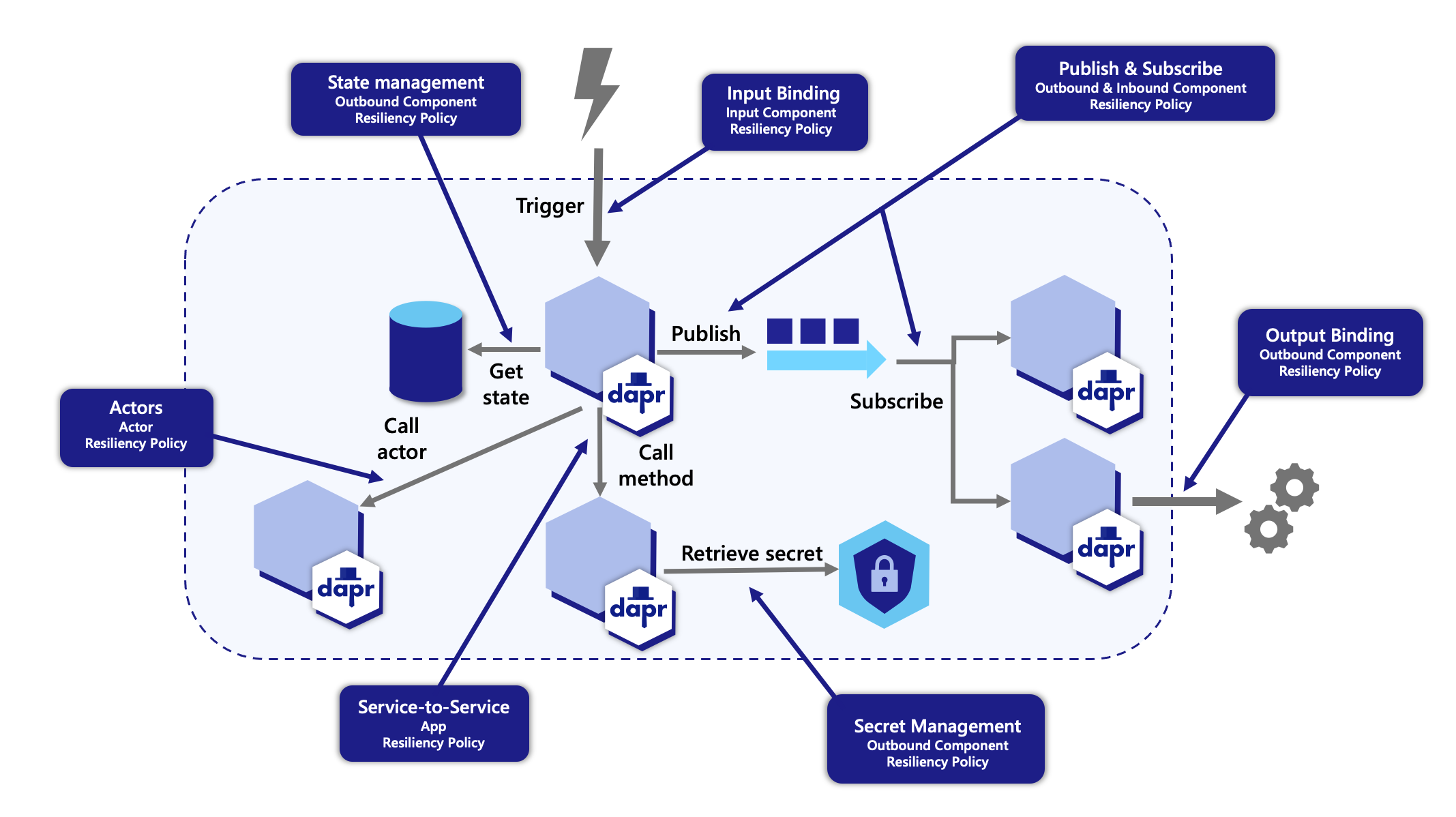
Dapr provides a capability for defining and applying fault tolerance resiliency policies to your application. You can define policies for following resiliency patterns:
These policies can be applied to any Dapr API calls when calling components with a resiliency spec.
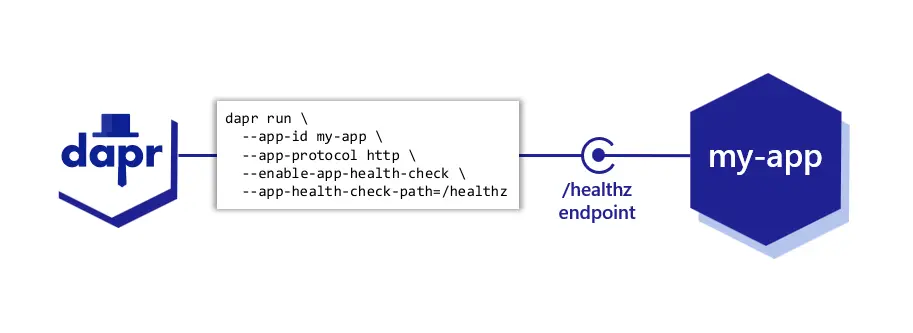
Applications can become unresponsive for a variety of reasons. For example, they are too busy to accept new work, could have crashed, or be in a deadlock state. Sometimes the condition can be transitory or persistent.
Dapr provides a capability for monitoring app health through probes that check the health of your application and react to status changes. When an unhealthy app is detected, Dapr stops accepting new work on behalf of the application.
Read more on how to apply app health checks to your application.
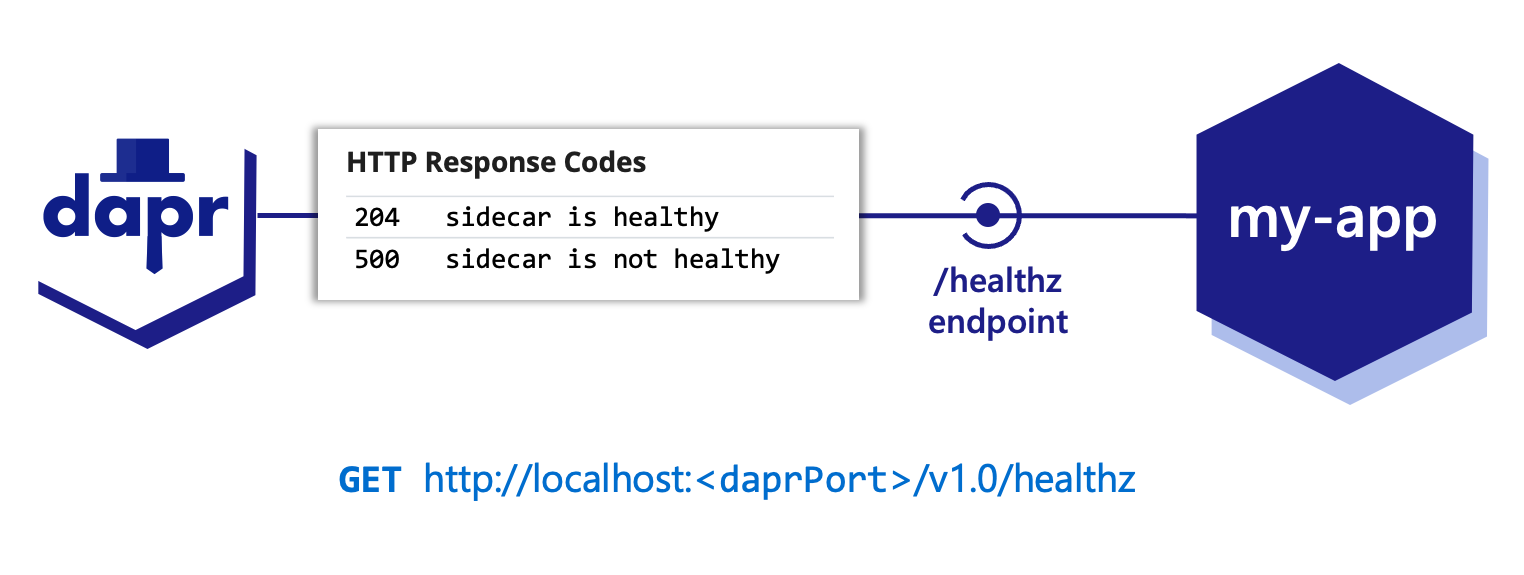
Dapr provides a way to determine its health using an HTTP /healthz endpoint. With this endpoint, the daprd process, or sidecar, can be:
Read more on about how to apply dapr health checks to your application.
When building an application, understanding the system behavior is an important, yet challenging part of operating it, such as:
This can be particularly challenging for a distributed system comprised of multiple microservices, where a flow made of several calls may start in one microservice and continue in another.
Observability into your application is critical in production environments, and can be useful during development to:
While some data points about an application can be gathered from the underlying infrastructure (memory consumption, CPU usage), other meaningful information must be collected from an “application-aware” layer – one that can show how an important series of calls is executed across microservices. Typically, you’d add some code to instrument an application, which simply sends collected data (such as traces and metrics) to observability tools or services that can help store, visualize, and analyze all this information.
Maintaining this instrumentation code, which is not part of the core logic of the application, requires understanding the observability tools’ APIs, using additional SDKs, etc. This instrumentation may also present portability challenges for your application, requiring different instrumentation depending on where the application is deployed. For example:
When you leverage Dapr API building blocks to perform service-to-service calls, pub/sub messaging, and other APIs, Dapr offers an advantage with respect to distributed tracing. Since this inter-service communication flows through the Dapr runtime (or “sidecar”), Dapr is in a unique position to offload the burden of application-level instrumentation.
Dapr can be configured to emit tracing data using the widely adopted protocols of Open Telemetry (OTEL) and Zipkin. This makes it easily integrated with multiple observability tools.
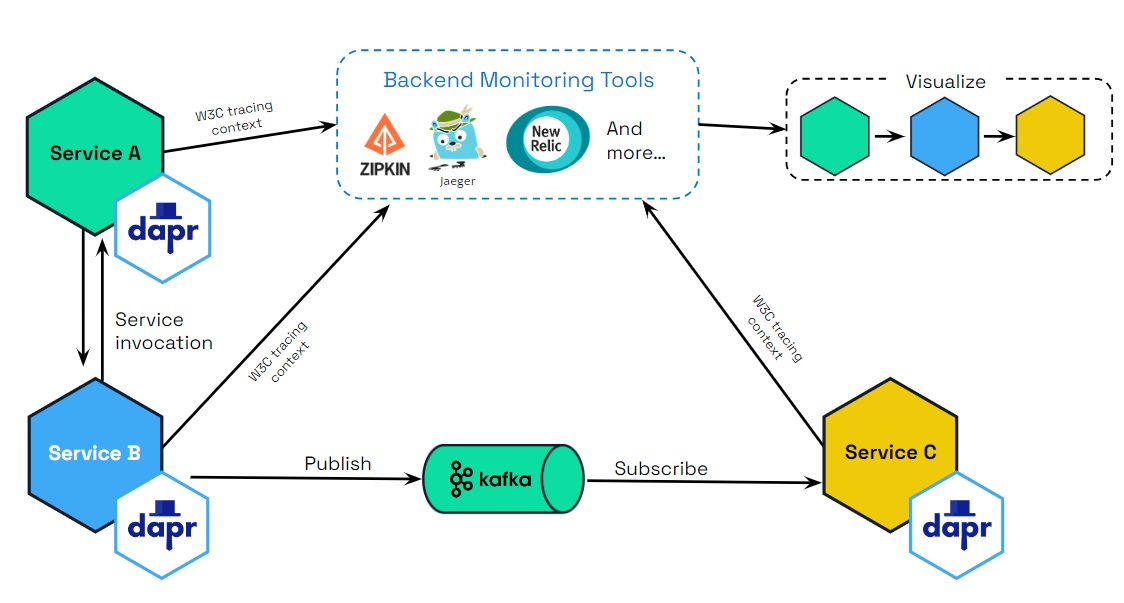
Dapr uses the W3C tracing specification for tracing context, included as part Open Telemetry (OTEL), to generate and propagate the context header for the application or propagate user-provided context headers. This means that you get tracing by default with Dapr.
You can also observe Dapr itself, by:
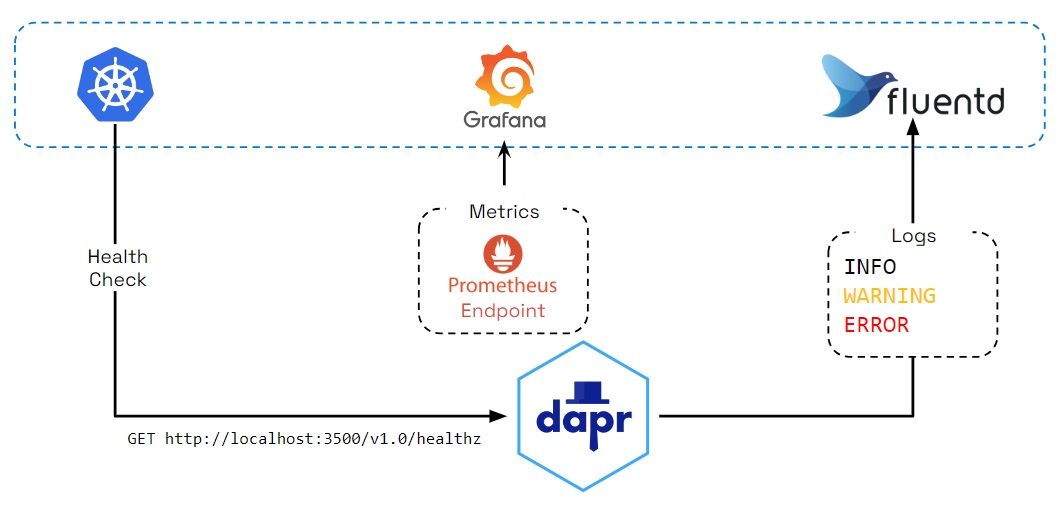
Dapr generates logs to:
Log events contain warning, error, info, and debug messages produced by Dapr system services. You can also configure Dapr to send logs to collectors, such as Open Telemetry Collector, Fluentd, New Relic, Azure Monitor, and other observability tools, so that logs can be searched and analyzed to provide insights.
Metrics are a series of measured values and counts collected and stored over time. Dapr metrics provide monitoring capabilities to understand the behavior of the Dapr sidecar and control plane. For example, the metrics between a Dapr sidecar and the user application show call latency, traffic failures, error rates of requests, etc.
Dapr control plane metrics show sidecar injection failures and the health of control plane services, including CPU usage, number of actor placements made, etc.
The Dapr sidecar exposes an HTTP endpoint for health checks. With this API, user code or hosting environments can probe the Dapr sidecar to determine its status and identify issues with sidecar readiness.
Conversely, Dapr can be configured to probe for the health of your application, and react to changes in the app’s health, including stopping pub/sub subscriptions and short-circuiting service invocation calls.
Security is fundamental to Dapr. This article describes the security features and capabilities when using Dapr in a distributed application. These can be divided into:
An example application is used to illustrate many of the security features available in Dapr.
Dapr provides end-to-end security with the service invocation API, with the ability to authenticate an application with Dapr and set endpoint access policies. This is shown in the diagram below.

In Dapr, Application Identity is built around the concept of an App ID. The App ID is the single atomic unit of identity in Dapr:
For example, when one service calls another using Dapr’s service invocation API, it calls the target by its App ID rather than its network location. This abstraction ensures that security policies, mutual TLS (mTLS) certificates, and access controls consistently apply at the application identity level.
While App IDs uniquely identify applications, namespaces provide an additional layer of scoping and isolation, especially in multi-tenant or large environments.
Dapr applications can be scoped to namespaces for deployment and security. You can call between services deployed to different namespaces. Read the Service invocation across namespaces article for more details.
Dapr applications can restrict which operations can be called, including which applications are allowed (or denied) to call it. Read How-To: Apply access control list configuration for service invocation for more details.
For pub/sub components, you can limit which topic types and applications are allowed to publish and subscribe to specific topics. Read Scope Pub/Sub topic access for more details.
One of Dapr’s security mechanisms for encrypting data in transit is mutual authentication TLS or mTLS. mTLS offers a few key features for network traffic inside your application:
mTLS is useful in almost all scenarios, but especially for systems subject to regulations such as HIPAA and PCI.
Dapr enables mTLS with no extra code or complex configuration inside your production systems. Equally, Dapr sidecars prevent all IP addresses by default other than localhost from calling it, unless explicitly listed.
Dapr includes an “on by default”, automatic mTLS that provides in-transit encryption for traffic between Dapr sidecars. To achieve this, Dapr leverages a system service named Sentry, which acts as a Certificate Authority (CA)/Identity Provider and signs workload (app) certificate requests originating from the Dapr sidecar.
By default, a workload certificate is valid for 24 hours and the clock skew is set to 15 minutes.
Unless you’ve provided existing root certificates, the Sentry service automatically creates and persists self-signed root certificates valid for one year. Dapr manages workload certificate rotation; if you bring your own certificates, Dapr does so with zero downtime to the application.
When root certificates are replaced (secret in Kubernetes mode and filesystem for self-hosted mode), Sentry picks them up and rebuilds the trust chain, without restart and with zero downtime to Sentry.
When a new Dapr sidecar initializes, it checks if mTLS is enabled. If so, an ECDSA private key and certificate signing request are generated and sent to Sentry via a gRPC interface. The communication between the Dapr sidecar and Sentry is authenticated using the trust chain certificate, which is injected into each Dapr instance by the Dapr Sidecar Injector system service.
mTLS can be turned on/off by editing the default configuration deployed with Dapr via the spec.mtls.enabled field.
You can do this for both Kubernetes and self-hosted modes.
The diagram below shows how the Sentry system service issues certificates for applications based on the root/issuer certificate provided by an operator or generated by the Sentry service as stored in a file.
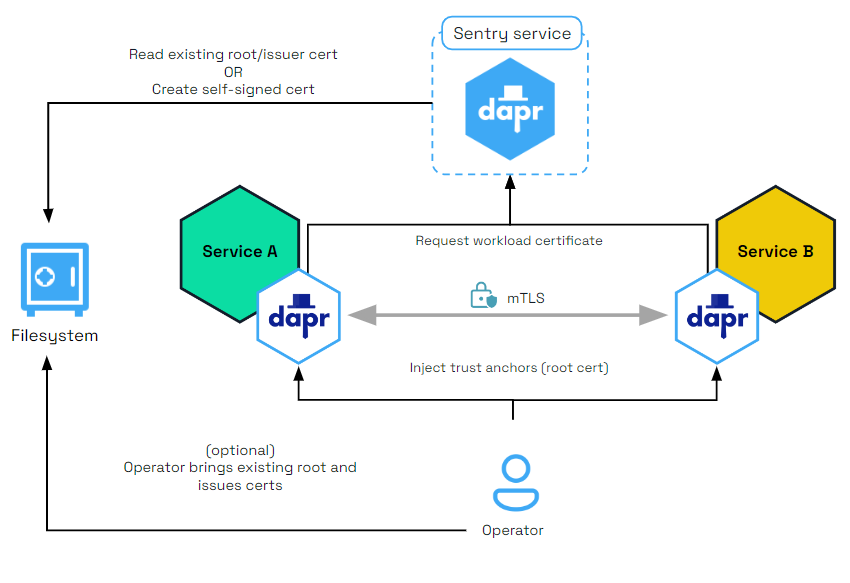
In a Kubernetes cluster, the secret that holds the root certificates is:
Dapr also supports strong identities when deployed on Kubernetes, relying on a pod’s Service Account token sent as part of the certificate signing request (CSR) to Sentry.
The diagram below shows how the Sentry system service issues certificates for applications based on the root/issuer certificate provided by an operator or generated by the Sentry service and stored as a Kubernetes secret

To prevent Dapr sidecars from being called on any IP address (especially in production environments such as Kubernetes), Dapr restricts its listening IP addresses to localhost. Use the dapr-listen-addresses setting if you need to enable access from external addresses.
The Dapr sidecar runs close to the application through localhost, and is recommended to run under the same network boundary as the app. While many cloud-native systems today consider the pod level (on Kubernetes, for example) as a trusted security boundary, Dapr provides the app with API level authentication using tokens. This feature guarantees that, even on localhost:
For more details on configuring API token security, read:
In addition to automatic mTLS between Dapr sidecars, Dapr offers mandatory mTLS between:
When mTLS is enabled, Sentry writes the root and issuer certificates to a Kubernetes secret scoped to the namespace where the control plane is installed. In self-hosted mode, Sentry writes the certificates to a configurable file system path.
In Kubernetes, when Dapr system services start, they automatically mount and use the secret containing the root and issuer certs to secure the gRPC server used by the Dapr sidecar. In self-hosted mode, each system service can be mounted to a filesystem path to get the credentials.
When the Dapr sidecar initializes, it authenticates with the system pods using the mounted leaf certificates and issuer private key. These are mounted as environment variables on the sidecar container.
The diagram below shows secure communication between the Dapr sidecar and the Dapr Sentry (Certificate Authority), Placement (actor placement), and the Kubernetes Operator system services.
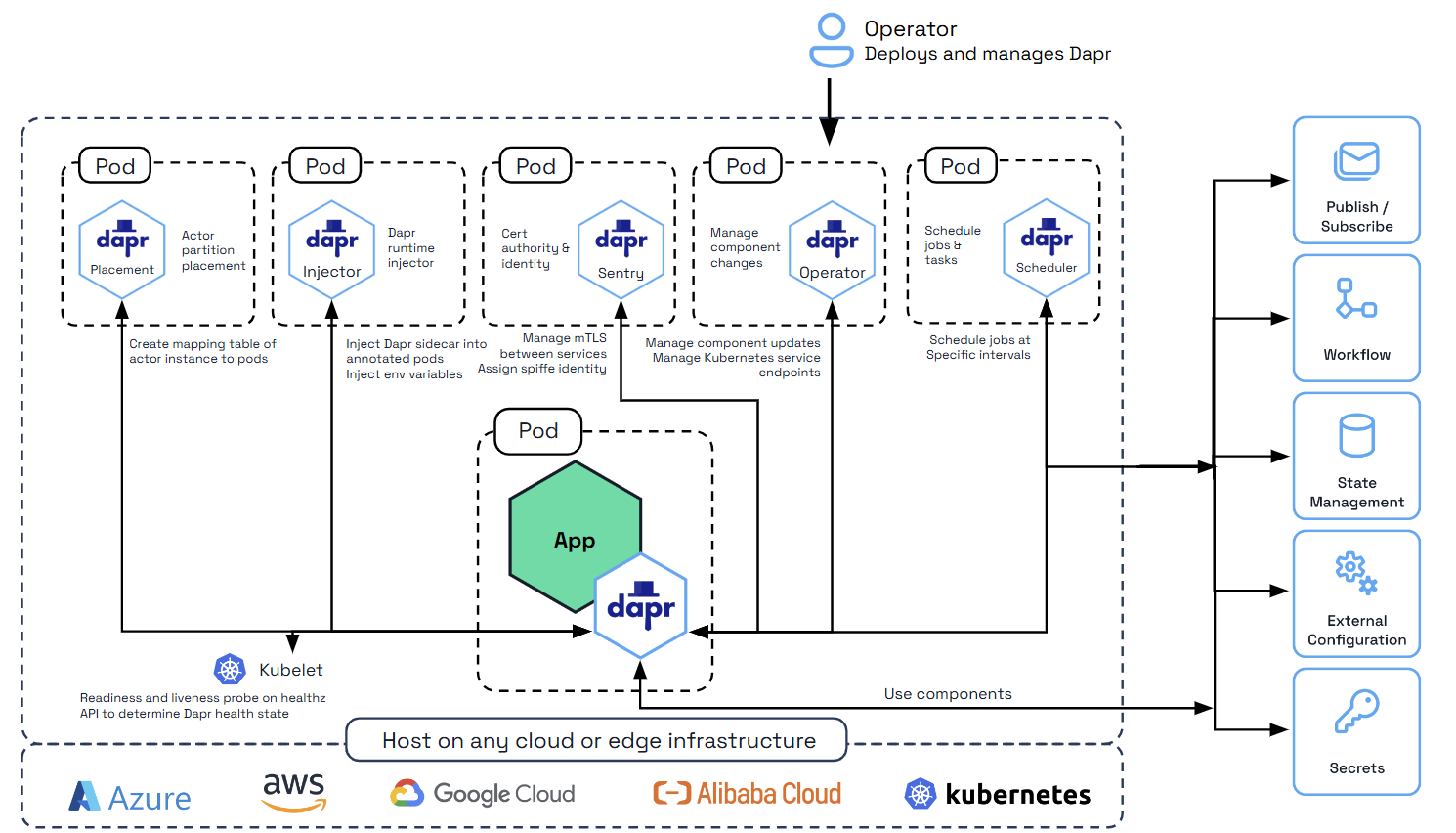
Dapr is designed for operators to manage mTLS certificates and enforce OAuth policies.
While operators and developers can bring their own certificates into Dapr, Dapr automatically creates and persists self-signed root and issuer certificates. Read Setup & configure mTLS certificates for more details.
With Dapr OAuth 2.0 middleware, you can enable OAuth authorization on Dapr endpoints for your APIs. Read Configure endpoint authorization with OAuth for details. Dapr has other middleware components that you can use for OpenID Connect and OPA Policies. For more details, read about supported middleware.
You can adopt common network security technologies, such as network security groups (NSGs), demilitarized zones (DMZs), and firewalls, to provide layers of protection over your networked resources. For example, unless configured to talk to an external binding target, Dapr sidecars don’t open connections to the internet and most binding implementations only use outbound connections. You can design your firewall rules to allow outbound connections only through designated ports.
Dapr has an extensive set of security policies you can apply to your applications. You can scope what they are able to do, either through a policy setting in the sidecar configuration, or with the component specification.
In certain scenarios, such as with zero trust networks or when exposing the Dapr sidecar to external traffic through a frontend, it’s recommended to only enable the Dapr sidecar APIs currently used by the app. This reduces the attack surface and keeps the Dapr APIs scoped to the actual needs of the application. You can control which APIs are accessible to the application by setting an API allow list in configuration, as shown in the diagram below.
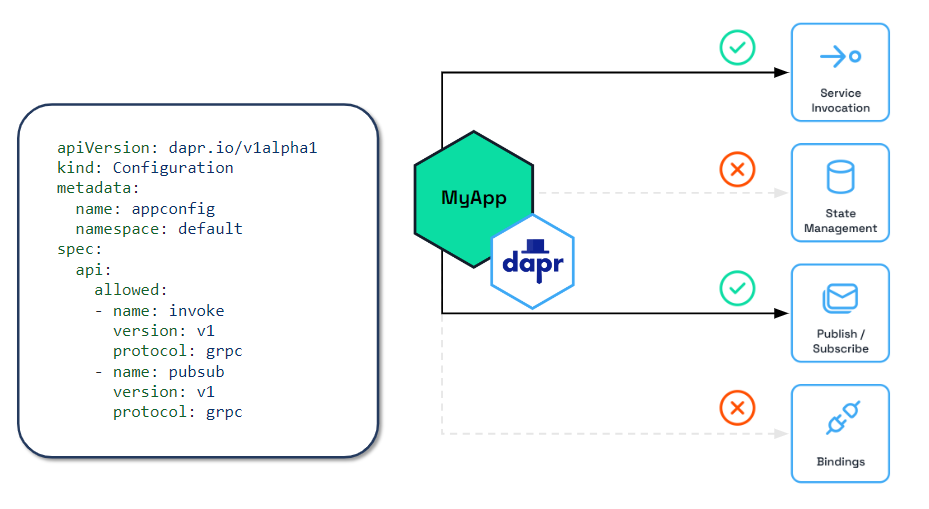
Read How-To: Selectively enable Dapr APIs on the Dapr sidecar for more details.
To limit the Dapr application’s access to secrets, you can define secret scopes. Add a secret scope policy to the application configuration with restrictive permissions. Read How To: Use secret scoping for more details.
Dapr components can be namespaced. That means a Dapr sidecar instance can only access the components that have been deployed to the same namespace. Read How-To: Scope components to one or more applications using namespaces for more details.
Dapr provides application-level scoping for components by allowing you to specify which applications can consume specific components and deny others. Read restricting application access to components with scopes for more details.
Dapr components can use Dapr’s built-in secret management capability to manage secrets. Read the secret store overview and How-To: Reference secrets in components for more details.
Authentication with a binding target is configured by the binding’s configuration file. Generally, you should configure the minimum required access rights. For example, if you only read from a binding target, you should configure the binding to use an account with read-only access rights.
By default Dapr doesn’t transform the state data from applications. This means:
Dapr components can use a configured authentication method to authenticate with the underlying state store. Many state store implementations use official client libraries that generally use secured communication channels with the servers.
However, application state often needs to get encrypted at rest to provide stronger security in enterprise workloads or regulated environments. Dapr provides automatic client-side state encryption based on AES256. Read How-To: Encrypt application state for more details.
The Dapr runtime does not store any data at rest, meaning that Dapr runtime has no dependency on any state stores for its operation and can be considered stateless.
The diagram below shows a number of security capabilities placed in an example application hosted on Kubernetes. In the example, the Dapr control plane, the Redis state store, and each of the services have been deployed to their own namespaces. When deploying on Kubernetes, you can use regular Kubernetes RBAC to control access to management activities.
In the application, requests are received by the ingress reverse-proxy which has a Dapr sidecar running next to it. From the reverse proxy, Dapr uses service invocation to call onto Service A, which then publishes a message to Service B. Service B retrieves a secret in order to read and save state to a Redis state store.
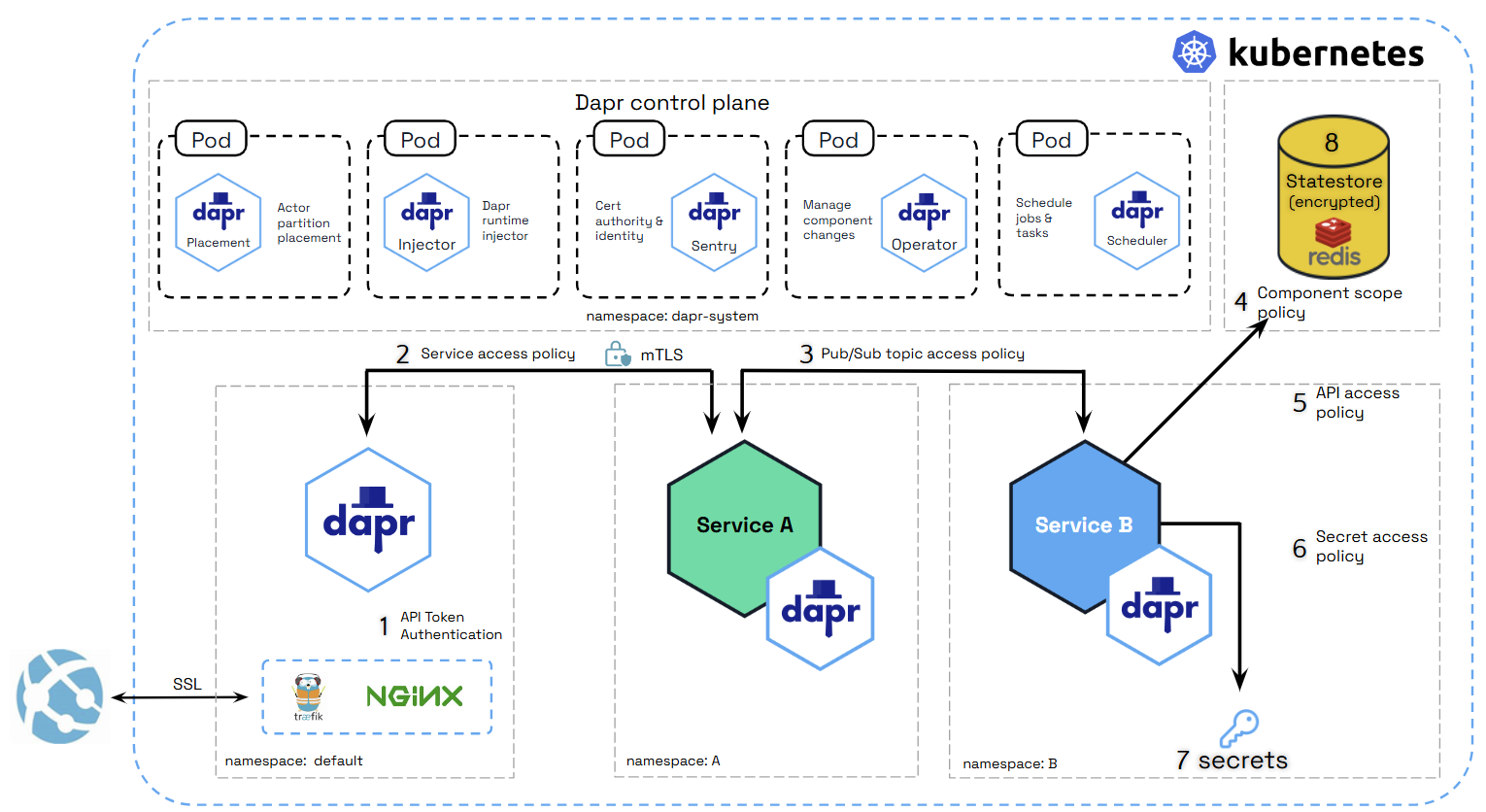
Let’s go over each of the security capabilities and describe how they are protecting this application.
Threat modeling is a process by which:
The Dapr threat model is below.
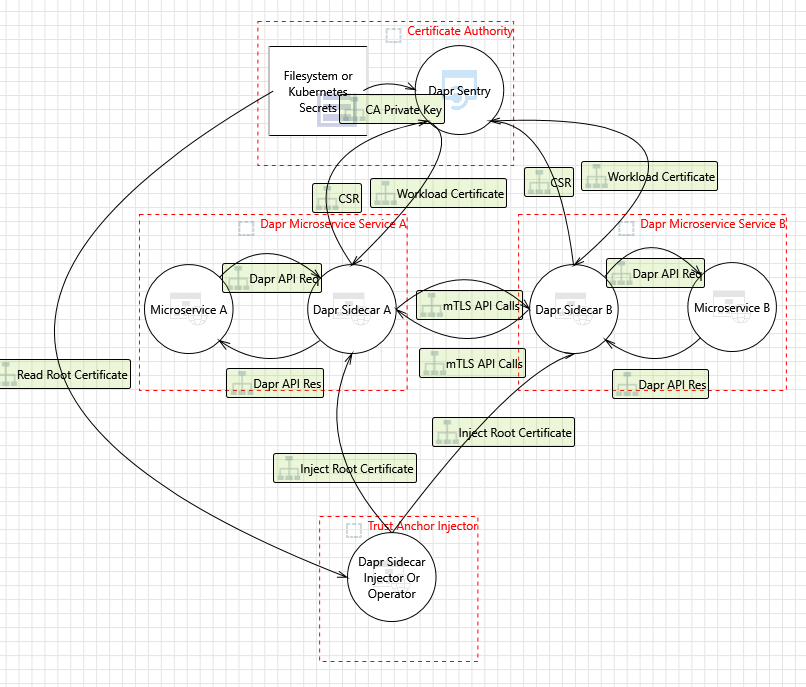
In September 2023, Dapr completed a security audit done by Ada Logics.
The audit was a holistic security audit with the following goals:
You can find the full report here.
The audit found 7 issues none of which were of high or critical severity. One CVE was assigned from an issue in a 3rd-party dependency to Dapr Components Contrib
In June 2023, Dapr completed a fuzzing audit done by Ada Logics.
The audit achieved the following:
You can find the full report here.
3 issues were found during the audit.
In February 2021, Dapr went through a 2nd security audit targeting its 1.0 release by Cure53.
The test focused on the following:
You can find the full report here.
One high issue was detected and fixed during the test.
As of February 16, 2021, Dapr has 0 criticals, 0 highs, 0 mediums, 2 lows, 2 infos.
In June 2020, Dapr underwent a security audit from Cure53, a CNCF-approved cybersecurity firm.
The test focused on the following:
The full report can be found here.
Visit this page to report a security issue to the Dapr maintainers.
Dapr namespacing provides isolation and multi-tenancy across many capabilities, giving greater security. Typically applications and components are deployed to namespaces to provide isolation in a given environment, such as Kubernetes.
Dapr supports namespacing in service invocation calls between applications, when accessing components, sending pub/sub messages in consumer groups, and with actors type deployments as examples. Namespacing isolation is supported in both self-hosted and Kubernetes modes.
To get started, create and configure your namespace.
In self-hosted mode, specify the namespace for a Dapr instance by setting the NAMESPACE environment variable.
On Kubernetes, create and configure the namespace:
kubectl create namespace namespaceA
kubectl config set-context --current --namespace=namespaceA
Then deploy your applications into this namespace.
Learn how to use namespacing throughout Dapr:
Dapr uses a sidecar pattern, meaning the Dapr APIs are run and exposed on a separate process, the Dapr sidecar, running alongside your application. The Dapr sidecar process is named daprd and is launched in different ways depending on the hosting environment.
The Dapr sidecar exposes:
The Dapr sidecar will reach readiness state once the application is accessible on its configured port. The application cannot access the Dapr components during application start up/initialization.
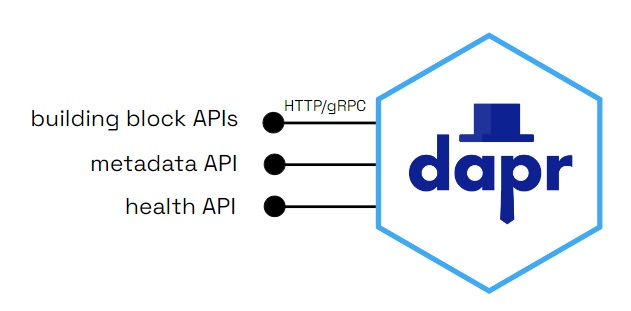
The sidecar APIs are called from your application over local http or gRPC endpoints.

dapr runWhen Dapr is installed in self-hosted mode, the daprd binary is downloaded and placed under the user home directory ($HOME/.dapr/bin for Linux/macOS or %USERPROFILE%\.dapr\bin\ for Windows).
In self-hosted mode, running the Dapr CLI run command launches the daprd executable with the provided application executable. This is the recommended way of running the Dapr sidecar when working locally in scenarios such as development and testing.
You can find the various arguments that the CLI exposes to configure the sidecar in the Dapr run command reference.
dapr-sidecar-injectorOn Kubernetes, the Dapr control plane includes the dapr-sidecar-injector service, which watches for new pods with the dapr.io/enabled annotation and injects a container with the daprd process within the pod. In this case, sidecar arguments can be passed through annotations as outlined in the Kubernetes annotations column in this table.
In most cases you do not need to run daprd explicitly, as the sidecar is either launched by the CLI (self-hosted mode) or by the dapr-sidecar-injector service (Kubernetes). For advanced use cases (debugging, scripted deployments, etc.) the daprd process can be launched directly.
For a detailed list of all available arguments run daprd --help or see this table which outlines how the daprd arguments relate to the CLI arguments and Kubernetes annotations.
Start a sidecar alongside an application by specifying its unique ID.
Note: --app-id is a required field, and cannot contain dots.
daprd --app-id myapp
Specify the port your application is listening to
daprd --app-id myapp --app-port 5000
If you are using several custom resources and want to specify the location of the resource definition files, use the --resources-path argument:
daprd --app-id myapp --resources-path <PATH-TO-RESOURCES-FILES>
If you’ve organized your components and other resources (for example, resiliency policies, subscriptions, or configuration) into separate folders or a shared folder, you can specify multiple resource paths:
daprd --app-id myapp --resources-path <PATH-1-TO-RESOURCES-FILES> --resources-path <PATH-2-TO-RESOURCES-FILES>
Enable collection of Prometheus metrics while running your app
daprd --app-id myapp --enable-metrics
Listen to IPv4 and IPv6 loopback only
daprd --app-id myapp --dapr-listen-addresses '127.0.0.1,[::1]'
When running Dapr in Kubernetes mode, a pod running the Dapr Operator service manages Dapr component updates and provides Kubernetes services endpoints for Dapr.
The operator service is deployed as part of dapr init -k, or via the Dapr Helm charts. For more information on running Dapr on Kubernetes, visit the Kubernetes hosting page.
The operator service includes additional configuration options.
The operator service includes an injector watchdog feature which periodically polls all pods running in your Kubernetes cluster and confirms that the Dapr sidecar is injected in those which have the dapr.io/enabled=true annotation. It is primarily meant to address situations where the Injector service did not successfully inject the sidecar (the daprd container) into pods.
The injector watchdog can be useful in a few situations, including:
Recovering from a Kubernetes cluster completely stopped. When a cluster is completely stopped and then restarted (including in the case of a total cluster failure), pods are restarted in a random order. If your application is restarted before the Dapr control plane (specifically the Injector service) is ready, the Dapr sidecar may not be injected into your application’s pods, causing your application to behave unexpectedly.
Addressing potential random failures with the sidecar injector, such as transient failures within the Injector service.
If the watchdog detects a pod that does not have a sidecar when it should have had one, it deletes it. Kubernetes will then re-create the pod, invoking the Dapr sidecar injector again.
The injector watchdog feature is disabled by default.
You can enable it by passing the --watch-interval flag to the operator command, which can take one of the following values:
--watch-interval=0: disables the injector watchdog (default value if the flag is omitted).--watch-interval=<interval>: the injector watchdog is enabled and polls all pods at the given interval; the value for the interval is a string that includes the unit. For example: --watch-interval=10s (every 10 seconds) or --watch-interval=2m (every 2 minutes).--watch-interval=once: the injector watchdog runs only once when the operator service is started.If you’re using Helm, you can configure the injector watchdog with the dapr_operator.watchInterval option, which has the same values as the command line flags.
The injector watchdog is safe to use when the operator service is running in HA (High Availability) mode with more than one replica. In this case, Kubernetes automatically elects a “leader” instance which is the only one that runs the injector watchdog service.
However, when in HA mode, if you configure the injector watchdog to run “once”, the watchdog polling is actually started every time an instance of the operator service is elected as leader. This means that, should the leader of the operator service crash and a new leader be elected, that would trigger the injector watchdog again.
Watch this video for an overview of the injector watchdog:
The Dapr Placement service is used to calculate and distribute distributed hash tables for the location of Dapr actors running in self-hosted mode or on Kubernetes. Grouped by namespace, the hash tables map actor types to pods or processes so a Dapr application can communicate with the actor. Anytime a Dapr application activates a Dapr actor, the Placement service updates the hash tables with the latest actor location.
The Placement service Docker container is started automatically as part of dapr init. It can also be run manually as a process if you are running in slim-init mode.
The Placement service is deployed as part of dapr init -k, or via the Dapr Helm charts. You can run Placement in high availability (HA) mode. Learn more about setting HA mode in your Kubernetes service.
For more information on running Dapr on Kubernetes, visit the Kubernetes hosting page.
There is an HTTP API /placement/state for Placement service that exposes placement table information. The API is exposed on the sidecar on the same port as the healthz. This is an unauthenticated endpoint, and is disabled by default. You need to set DAPR_PLACEMENT_METADATA_ENABLED environment or metadata-enabled command line args to true to enable it. If you are using helm you just need to set dapr_placement.metadataEnabled to true.
metadata-enabled if you want to prevent retrieving actors from all namespaces. The metadata endpoint is scoped to all namespaces.The placement table API can be used to retrieve the current placement table, which contains all the actors registered across all namespaces. This is helpful for debugging and allowing tools to extract and present information about actors.
GET http://localhost:<healthzPort>/placement/state
| Code | Description |
|---|---|
| 200 | Placement tables information returned |
| 500 | Placement could not return the placement tables information |
Placement tables API Response Object
| Name | Type | Description |
|---|---|---|
| tableVersion | int | The placement table version |
| hostList | Actor Host Info[] | A json array of registered actors host info. |
| Name | Type | Description |
|---|---|---|
| name | string | The host:port address of the actor. |
| appId | string | app id. |
| actorTypes | json string array | List of actor types it hosts. |
| updatedAt | timestamp | Timestamp of the actor registered/updated. |
curl localhost:8080/placement/state
{
"hostList": [{
"name": "198.18.0.1:49347",
"namespace": "ns1",
"appId": "actor1",
"actorTypes": ["testActorType1", "testActorType3"],
"updatedAt": 1690274322325260000
},
{
"name": "198.18.0.2:49347",
"namespace": "ns2",
"appId": "actor2",
"actorTypes": ["testActorType2"],
"updatedAt": 1690274322325260000
},
{
"name": "198.18.0.3:49347",
"namespace": "ns2",
"appId": "actor2",
"actorTypes": ["testActorType2"],
"updatedAt": 1690274322325260000
}
],
"tableVersion": 1
}
The Placement service can be disabled with the following setting:
global.actors.enabled=false
The Placement service is not deployed with this setting in Kubernetes mode. This not only disables actor deployment, but also disables workflows, given that workflows use actors. This setting only applies in Kubernetes mode, however initializing Dapr with --slim excludes the Placement service from being deployed in self-hosted mode.
For more information on running Dapr on Kubernetes, visit the Kubernetes hosting page.
The Dapr Scheduler service is used to schedule different types of jobs, running in self-hosted mode or on Kubernetes.
From Dapr v1.15, the Scheduler service is used by default to schedule actor reminders as well as actor reminders for the Workflow API.
There is no concept of a leader Scheduler instance. All Scheduler service replicas are considered peers. All receive jobs to be scheduled for execution and the jobs are allocated between the available Scheduler service replicas for load balancing of the trigger events.
The diagram below shows how the Scheduler service is used via the jobs API when called from your application. All the jobs that are tracked by the Scheduler service are stored in the Etcd database.

By default, Etcd is embedded in the Scheduler service, which means that the Scheduler service runs its own instance of Etcd. See Scheduler service flags for more information on how to configure the Scheduler service.
Prior to Dapr v1.15, actor reminders were run using the Placement service. Now, by default, the SchedulerReminders feature flag is set to true, and all new actor reminders you create are run using the Scheduler service to make them more scalable.
When you deploy Dapr v1.15, any existing actor reminders are automatically migrated from the Actor State Store to the Scheduler service as a one time operation for each actor type. Each replica will only migrate the reminders whose actor type and id are associated with that host. This means that only when all replicas implementing an actor type are upgraded to 1.15, will all the reminders associated with that type be migrated. There will be no loss of reminder triggers during the migration. However, you can prevent this migration and keep the existing actor reminders running using the Actor State Store by setting the SchedulerReminders flag to false in the application configuration file for the actor type.
To confirm that the migration was successful, check the Dapr sidecar logs for the following:
Running actor reminder migration from state store to scheduler
coupled with
Migrated X reminders from state store to scheduler successfully
or
Skipping migration, no missing scheduler reminders found
By default, when the Scheduler service triggers jobs, they are sent back to a single replica for the same app ID that scheduled the job in a randomly load balanced manner. This provides basic load balancing across your application’s replicas, which is suitable for most use cases where strict locality isn’t required.
For users who require perfect job locality (having jobs triggered on the exact same host that created them), actor reminders provide a solution. To enforce perfect locality for a job:
This approach ensures that the job will always be triggered on the same host which created it, rather than being randomly distributed among replicas.
When the Scheduler service triggers a job and it has a client side error, the job is retried by default with a 1s interval and 3 maximum retries.
For non-client side errors, for example, when a job cannot be sent to an available Dapr sidecar at trigger time, it is placed in a staging queue within the Scheduler service. Jobs remain in this queue until a suitable sidecar instance becomes available, at which point they are automatically sent to the appropriate Dapr sidecar instance.
The Scheduler service Docker container is started automatically as part of dapr init. It can also be run manually as a process if you are running in slim-init mode.
The Scheduler can be run in both high availability (HA) and non-HA modes in self-hosted deployments. However, non-HA mode is not recommended for production use. If switching between non-HA and HA modes, the existing data directory must be removed, which results in loss of jobs and actor reminders. Run a back-up before making this change to avoid losing data.
The Scheduler service is deployed as part of dapr init -k, or via the Dapr Helm charts. Scheduler always runs in high availability (HA) mode in Kubernetes deployments. Scaling the Scheduler service replicas up or down is not possible without incurring data loss due to the nature of the embedded data store. Learn more about setting HA mode in your Kubernetes service.
When a Kubernetes namespace is deleted, all the Job and Actor Reminders corresponding to that namespace are deleted.
Here’s how to expose the etcd ports in a Docker Compose configuration for standalone mode. When running in HA mode, you only need to expose the ports for one scheduler instance to perform backup operations.
version: "3.5"
services:
scheduler-0:
image: "docker.io/daprio/scheduler:1.16.0"
command:
- "./scheduler"
- "--etcd-data-dir=/var/run/dapr/scheduler"
- "--id=scheduler-0"
- "--etcd-initial-cluster=scheduler-0=http://scheduler-0:2380,scheduler-1=http://scheduler-1:2380,scheduler-2=http://scheduler-2:2380"
ports:
- 2379:2379
volumes:
- ./dapr_scheduler/0:/var/run/dapr/scheduler
scheduler-1:
image: "docker.io/daprio/scheduler:1.16.0"
command:
- "./scheduler"
- "--etcd-data-dir=/var/run/dapr/scheduler"
- "--id=scheduler-1"
- "--etcd-initial-cluster=scheduler-0=http://scheduler-0:2380,scheduler-1=http://scheduler-1:2380,scheduler-2=http://scheduler-2:2380"
volumes:
- ./dapr_scheduler/1:/var/run/dapr/scheduler
scheduler-2:
image: "docker.io/daprio/scheduler:1.16.0"
command:
- "./scheduler"
- "--etcd-data-dir=/var/run/dapr/scheduler"
- "--id=scheduler-2"
- "--etcd-initial-cluster=scheduler-0=http://scheduler-0:2380,scheduler-1=http://scheduler-1:2380,scheduler-2=http://scheduler-2:2380"
volumes:
- ./dapr_scheduler/2:/var/run/dapr/scheduler
In production environments, it’s recommended to perform periodic backups of this data at an interval that aligns with your recovery point objectives.
To perform backup and restore operations, you’ll need to access the embedded etcd instance. This requires port forwarding to expose the etcd ports (port 2379).
Here’s how to port forward and connect to the etcd instance:
kubectl port-forward svc/dapr-scheduler-server 2379:2379 -n dapr-system
Once you have access to the etcd ports, you can follow the official etcd backup and restore documentation to perform backup and restore operations. The process involves using standard etcd commands to create snapshots and restore from them.
Port forward the Scheduler instance and view etcd’s metrics with the following:
curl -s http://localhost:2379/metrics
Fine tune the embedded etcd to your needs by reviewing and configuring the Scheduler’s etcd flags as needed.
If you are not using any features that require the Scheduler service (Jobs API, Actor Reminders, or Workflows), you can disable it by setting global.scheduler.enabled=false.
For more information on running Dapr on Kubernetes, visit the Kubernetes hosting page.
A number of Etcd flags are exposed on Scheduler which can be used to tune for your deployment use case.
Scheduler can be configured to use an external Etcd database instead of the embedded one inside the Scheduler service replicas. It may be interesting to decouple the storage volume from the Scheduler StatefulSet or container, because of how the cluster or environment is administered or what storage backend is being used. It can also be the case that moving the persistent storage outside of the scheduler runtime completely is desirable, or there is some existing Etcd cluster provider which will be reused. Externalising the Etcd database also means that the Scheduler replicas can be horizontally scaled at will, however note that during scale events, job triggering will be paused. Scheduler replica count does not need to match the Etcd node count constraints.
To use an external Etcd cluster, set the --etcd-embed flag to false and provide the --etcd-client-endpoints flag with the endpoints of your Etcd cluster.
Optionally also include --etcd-client-username and --etcd-client-password flags for authentication if the Etcd cluster requires it.
--etcd-embed bool When enabled, the Etcd database is embedded in the scheduler server. If false, the scheduler connects to an external Etcd cluster using the --etcd-client-endpoints flag. (default true)
--etcd-client-endpoints stringArray Comma-separated list of etcd client endpoints to connect to. Only used when --etcd-embed is false.
--etcd-client-username string Username for etcd client authentication. Only used when --etcd-embed is false.
--etcd-client-password string Password for etcd client authentication. Only used when --etcd-embed is false.
Helm:
dapr_scheduler.etcdEmbed=true
dapr_scheduler.etcdClientEndpoints=[]
dapr_scheduler.etcdClientUsername=""
dapr_scheduler.etcdClientPassword=""
To improve the speed of election leadership of rescue nodes in the event of a failure, the following flag may be used to speed up the election process.
--etcd-initial-election-tick-advance Whether to fast-forward initial election ticks on boot for faster election. When it is true, then local member fast-forwards election ticks to speed up “initial” leader election trigger. This benefits the case of larger election ticks. Disabling this would slow down initial bootstrap process for cross datacenter deployments. Make your own tradeoffs by configuring this flag at the cost of slow initial bootstrap.
Helm:
dapr_scheduler.etcdInitialElectionTickAdvance=true
The following options can be used to tune the embedded Etcd storage to the needs of your deployment. A deeper understanding of what these flags do can be found in the Etcd documentation.
--etcd-backend-batch-interval string Maximum time before committing the backend transaction. (default "50ms")
--etcd-backend-batch-limit int Maximum operations before committing the backend transaction. (default 5000)
--etcd-compaction-mode string Compaction mode for etcd. Can be 'periodic' or 'revision' (default "periodic")
--etcd-compaction-retention string Compaction retention for etcd. Can express time or number of revisions, depending on the value of 'etcd-compaction-mode' (default "10m")
--etcd-experimental-bootstrap-defrag-threshold-megabytes uint Minimum number of megabytes needed to be freed for etcd to consider running defrag during bootstrap. Needs to be set to non-zero value to take effect. (default 100)
--etcd-max-snapshots uint Maximum number of snapshot files to retain (0 is unlimited). (default 10)
--etcd-max-wals uint Maximum number of write-ahead logs to retain (0 is unlimited). (default 10)
--etcd-snapshot-count uint Number of committed transactions to trigger a snapshot to disk. (default 10000)
Helm:
dapr_scheduler.etcdBackendBatchInterval="50ms"
dapr_scheduler.etcdBackendBatchLimit=5000
dapr_scheduler.etcdCompactionMode="periodic"
dapr_scheduler.etcdCompactionRetention="10m"
dapr_scheduler.etcdDefragThresholdMB=100
dapr_scheduler.etcdMaxSnapshots=10
The Dapr Sentry service manages mTLS between services and acts as a certificate authority. It generates mTLS certificates and distributes them to any running sidecars. This allows sidecars to communicate with encrypted, mTLS traffic. For more information read the sidecar-to-sidecar communication overview.
The Sentry service Docker container is not started automatically as part of dapr init. However it can be executed manually by following the instructions for setting up mutual TLS.
It can also be run manually as a process if you are running in slim-init mode.

The sentry service is deployed as part of dapr init -k, or via the Dapr Helm charts. For more information on running Dapr on Kubernetes, visit the Kubernetes hosting page.

When running Dapr in Kubernetes mode, a pod is created running the Dapr Sidecar Injector service, which looks for pods initialized with the Dapr annotations, and then creates another container in that pod for the daprd service
The sidecar injector service is deployed as part of dapr init -k, or via the Dapr Helm charts. For more information on running Dapr on Kubernetes, visit the Kubernetes hosting page.
This page details all of the common terms you may come across in the Dapr docs.
| Term | Definition | More information |
|---|---|---|
| App/Application | A running service/binary, usually one that you as the user create and run. | |
| Building block | An API that Dapr provides to users to help in the creation of microservices and applications. | Dapr building blocks |
| Component | Modular types of functionality that are used either individually or with a collection of other components, by a Dapr building block. | Dapr components |
| Configuration | A YAML file declaring all of the settings for Dapr sidecars or the Dapr control plane. This is where you can configure control plane mTLS settings, or the tracing and middleware settings for an application instance. | Dapr configuration |
| Dapr | Distributed Application Runtime. | Dapr overview |
| Dapr control plane | A collection of services that are part of a Dapr installation on a hosting platform such as a Kubernetes cluster. This allows Dapr-enabled applications to run on the platform and handles Dapr capabilities such as actor placement, Dapr sidecar injection, or certificate issuance/rollover. | Self-hosted overview Kubernetes overview |
| HTTPEndpoint | HTTPEndpoint is a Dapr resource use to identify non-Dapr endpoints to invoke via the service invocation API. | Service invocation API |
| Namespacing | Namespacing in Dapr provides isolation, and thus provides multi-tenancy. | Learn more about namespacing components, service invocation, pub/sub, and actors |
| Self-hosted | Windows/macOS/Linux machine(s) where you can run your applications with Dapr. Dapr provides the capability to run on machines in “self-hosted” mode. | Self-hosted mode |
| Service | A running application or binary. This can refer to your application or to a Dapr application. | |
| Sidecar | A program that runs alongside your application as a separate process or container. | Sidecar pattern |
Dapr is not a service mesh. While service meshes focus on fine-grained network control, Dapr is focused on helping developers build distributed applications. Both Dapr and service meshes use the sidecar pattern and run alongside the application. They do have some overlapping features, but also offer unique benefits. For more information please read the Dapr & service meshes concept page.
The Dapr project is focused on performance due to the inherent discussion of Dapr being a sidecar to your application. See here for updated performance numbers.
The actors in Dapr are based on the same virtual actor concept that Orleans started, meaning that they are activated when called and deactivated after a period of time. If you are familiar with Orleans, Dapr C# actors will be familiar. Dapr C# actors are based on Service Fabric Reliable Actors (which also came from Orleans) and enable you to take Reliable Actors in Service Fabric and migrate them to other hosting platforms such as Kubernetes or other on-premises environments. Moreover, Dapr is about more than just actors. It provides you with a set of best-practice building blocks to build into any microservices application. See Dapr overview.
Virtual actor capabilities are one of the building blocks that Dapr provides in its runtime. With Dapr, because it is programming-language agnostic with an http/gRPC API, the actors can be called from any language. This allows actors written in one language to invoke actors written in a different language.
Creating a new actor follows a local call like http://localhost:3500/v1.0/actors/<actorType>/<actorId>/…. For example, http://localhost:3500/v1.0/actors/myactor/50/method/getData calls the getData method on the newly created myactor with id 50.
The Dapr runtime SDKs have language-specific actor frameworks. For example, the .NET SDK has C# actors. The goal is for all the Dapr language SDKs to have an actor framework. Currently .NET, Java, Go and Python SDK have actor frameworks.
To make using Dapr more natural for different languages, it includes language specific SDKs for Go, Java, JavaScript, .NET, Python, PHP, Rust and C++. These SDKs expose the functionality in the Dapr building blocks, such as saving state, publishing an event or creating an actor, through a typed language API rather than calling the http/gRPC API. This enables you to write a combination of stateless and stateful functions and actors all in the language of your choice. And because these SDKs share the Dapr runtime, you get cross-language actor and functions support.
Dapr can be integrated with any developer framework. For example, in the Dapr .NET SDK you can find ASP.NET Core integration, which brings stateful routing controllers that respond to pub/sub events from other services.
Dapr is integrated with the following frameworks;
Dapr uses a sidecar architecture, running as a separate process alongside the application and includes features such as service invocation, network security, and distributed tracing. This often raises the question: how does Dapr compare to service mesh solutions such as Linkerd, Istio and Open Service Mesh among others?
While Dapr and service meshes do offer some overlapping capabilities, Dapr is not a service mesh, where a service mesh is defined as a networking service mesh. Unlike a service mesh which is focused on networking concerns, Dapr is focused on providing building blocks that make it easier for developers to build applications as microservices. Dapr is developer-centric, versus service meshes which are infrastructure-centric.
In most cases, developers do not need to be aware that the application they are building will be deployed in an environment which includes a service mesh, since a service mesh intercepts network traffic. Service meshes are mostly managed and deployed by system operators, whereas Dapr building block APIs are intended to be used by developers explicitly in their code.
Some common capabilities that Dapr shares with service meshes include:
Importantly, Dapr provides service discovery and invocation via names, which is a developer-centric concern. This means that through Dapr’s service invocation API, developers call a method on a service name, whereas service meshes deal with network concepts such as IP addresses and DNS addresses. However, Dapr does not provide capabilities for traffic behavior such as routing or traffic splitting. Traffic routing is often addressed with ingress proxies to an application and does not have to use a service mesh. In addition, Dapr provides other application-level building blocks for state management, pub/sub messaging, actors, and more.
Another difference between Dapr and service meshes is observability (tracing and metrics). Service meshes operate at the network level and trace the network calls between services. Dapr does this with service invocation. Moreover, Dapr also provides observability (tracing and metrics) over pub/sub calls using trace IDs written into the Cloud Events envelope. This means that metrics and tracing with Dapr is more extensive than with a service mesh for applications that use both service-to-service invocation and pub/sub to communicate.
The illustration below captures the overlapping features and unique capabilities that Dapr and service meshes offer:
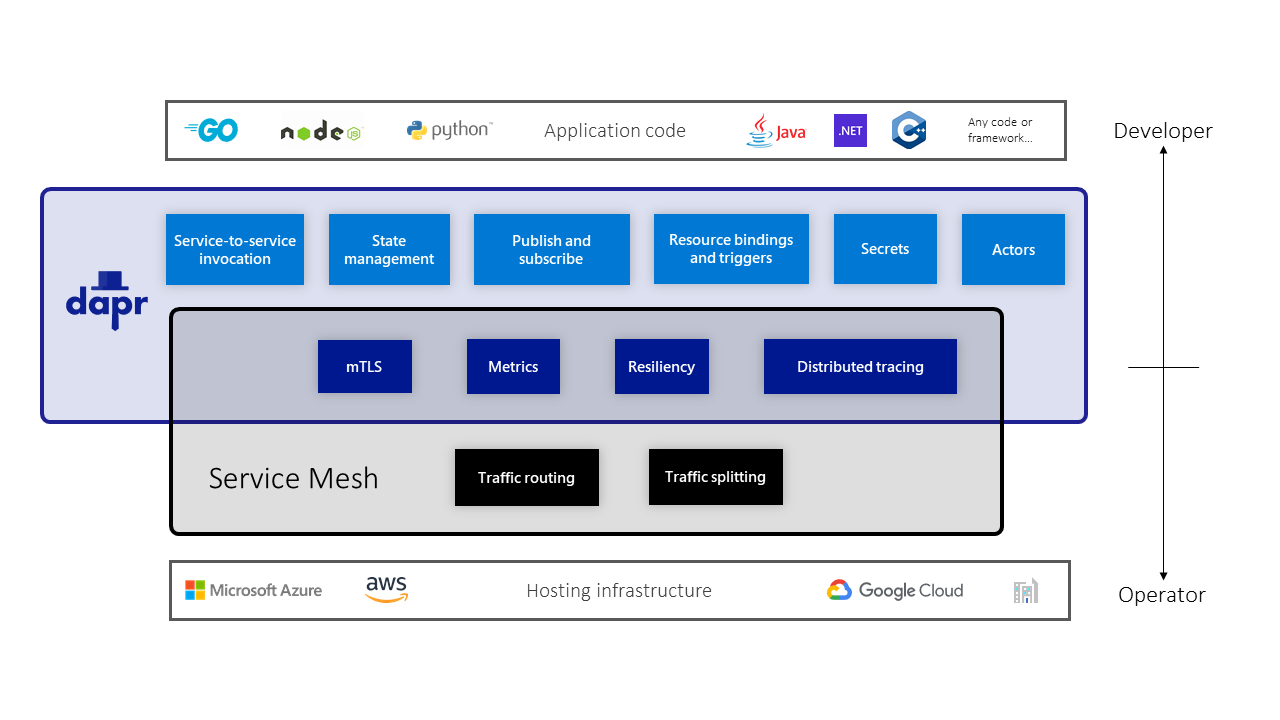
Dapr does work with service meshes. In the case where both are deployed together, both Dapr and service mesh sidecars are running in the application environment. In this case, it is recommended to configure only Dapr or only the service mesh to perform mTLS encryption and distributed tracing.
Watch these recordings from the Dapr community calls showing presentations on running Dapr together with different service meshes:
Should you be using Dapr, a service mesh, or both? The answer depends on your requirements. If, for example, you are looking to use Dapr for one or more building blocks such as state management or pub/sub, and you are considering using a service mesh just for network security or observability, you may find that Dapr is a good fit and that a service mesh is not required.
Typically you would use a service mesh with Dapr where there is a corporate policy that traffic on the network must be encrypted for all applications. For example, you may be using Dapr in only part of your application, and other services and processes that are not using Dapr in your application also need their traffic encrypted. In this scenario a service mesh is the better option, and most likely you should use mTLS and distributed tracing on the service mesh and disable this on Dapr.
If you need traffic splitting for A/B testing scenarios you would benefit from using a service mesh, since Dapr does not provide these capabilities.
In some cases, where you require capabilities that are unique to both, you will find it useful to leverage both Dapr and a service mesh; as mentioned above, there is no limitation to using them together.